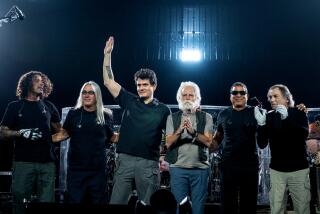Made in Wynn’s Image
- Share via
And on the seventh day, I showed up to pay my respects. I elbowed my way toward one of Steve Wynn’s gleaming new craps tables. Ah, I love the smell of fresh green felt in the evening. Someone rolled a seven within moments, and the rest of the night went pretty much like that. I didn’t take it personally -- Wynn is understandably in a hurry to recoup his eye-popping $2.7-billion investment. Still, I drew the line at the gift shop.
Sorry, Sebastian. I was in no mood to plop down $38 for a cap or $42 for an infant’s T-shirt. Instead, I got him a $10 pirate’s T-shirt across the Strip at Treasure Island, a casino Wynn built a decade ago -- which, in Vegas time, might as well have been the 1850s.
No other major American city owes so much of its prosperity -- and there is a great deal of intoxicatingly new, chaos-inducing prosperity in Las Vegas -- to one person as this place owes to Steve Wynn. The city turns 100 this week, but the modern-day phenomenon of Las Vegas dates back to 1989, the year Wynn, backed by Michael Milken’s junk bonds, opened the Mirage.
“Wynn saw a city no one else saw here, and made it happen,” says Alan Feldman, an L.A. native and former ad executive who moved to Las Vegas after the Mirage’s opening to handle Wynn’s public relations. He is now a competitor to Wynn, having stayed on at MGM Mirage after Kirk Kerkorian’s hostile takeover of Wynn’s old company.
Wynn believed that this desert oasis could be about a lot more than gambling. That the casino action merely helped set the escapist tone, which even non-gamblers would embrace. The big casino resorts in Las Vegas now make more money from their non-gambling operations, which can be hard to believe when you are rolling sevens in the casino or watching the crowds of Chinese gamblers earnestly trying to narrow our trade deficit with their country at Wynn’s $1,000-minimum baccarat tables.
Truth be told, Wynn’s new resort underwhelmed me at first. It’s oddly restrained, lacking the showy centerpiece that screams, “Look, Ma, I spent $2.7 billion.” A lot of thought went into breaking the 2,700-room resort into discrete, manageable spaces where you might be lulled into thinking you are at a tasteful hotel someplace other than Vegas. It’s hard at first to see where all the money went, until you find yourself admiring the restaurants’ decor or textiles adorning walls down some hallway, either on the way to the spa or to the hotel’s sumptuous conference rooms, where J.P. Morgan Chase was hosting an event during my visit.
As much as the baccarat rooms, these corporate meeting spaces are at the heart of what the new Las Vegas is all about. In a book I wrote in 1998 I described Las Vegas, America’s fastest-growing major city for some time, as the nation’s equivalent of a permanent World’s Fair, its gigantic hotel and convention spaces the equivalent of the old exposition palaces. The city’s evolution into the nation’s favored meeting place has only accelerated, even as Vegas has also solidified its status as the ultimate mecca for revelers of all ages. The conscious embrace of yesteryear’s naughtiness -- sexual innuendo is the town’s preferred marketing pitch -- woos both Gen Y weekenders in search of a good time and conventioneers eager to loosen up during the week.
With about 6,000 people moving into town each month, the population of Las Vegas is closing in on 2 million. According to census estimates, Clark County grew an astonishing 20% in the first four years of this decade.
The one thing I -- Vegas anthropologist that I am -- never saw coming was the city’s current condo craze. Exploding real estate values are altering the pattern of the city’s growth. Wynn bought the land on which the Bellagio now sits for $500,000 an acre, but it’s now worth about $25 million an acre. So Vegas is going vertical, with dozens of high-rise condos in the works. Many of the same Florida developers who sell condos from Miami Beach to Boca Raton are getting into the game, treating the Las Vegas Strip as if it were a beach. People eager to buy into the Las Vegas brand are paying more than $1 million for a two-bedroom apartment.
More so than Wynn’s new hotel, MGM Mirage Inc.’s 66-acre Project CityCenter, a tightly knit mix of residential towers, shopping venues and hotels slated to open on the Strip in 2009, will revolutionize how we think of Las Vegas. The company announced earlier this year that it had signed Cesar Pelli, the world-renowned architect, to design the complex’s centerpiece hotel. There will be no kitschy theme, of course, as this town’s ambitions have become improbably contrarian.
Las Vegas now wants to become a real city.
More to Read
Sign up for The Wild
We’ll help you find the best places to hike, bike and run, as well as the perfect silent spots for meditation and yoga.
You may occasionally receive promotional content from the Los Angeles Times.






